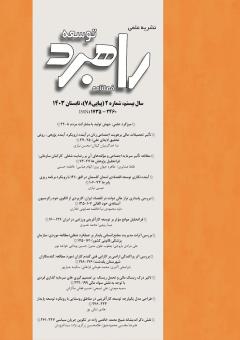فراتحلیل موانع مؤثر بر توسعه کارآفرینی ورزشی در ایران
محورهای موضوعی :
1 - 1- کارشناسی ارشد مدیریت ورزشی، گروه تربیت بدنی، واحد خوی، دانشگاه آزاد اسلامی، خوی، ایران
2 - استادیارمدیریت ورزشی، گروه تربیت بدنی، واحد خوی، دانشگاه آزاد اسلامی، خوی، ایران
کلید واژه: کلمات کلیدی: توسعه کارآفرینی ورزشی, اندازه اثر, فراتحلیل, موانع,
چکیده مقاله :
تحقیق حاضر با هدف فراتحلیل موانع مؤثر بر توسعه کارآفرینی ورزشی در ایران و به دست آوردن یک نتیجه منسجم از بین پژوهشهای متعدد انجام شد. روش تحقیق از نوع توصیفی و فراتحلیل بود. جامعه آماری این پژوهش همه تحقیقات داخلی مربوط به موانع کارآفرینی ورزشی در ایران در بازه زمانی سال 1389 الی 1402 بود. از بین تحقیقات گزارش شده 44 پژوهش که معیارهای ورود به فرایند فراتحلیل را داشتند، به عنوان نمونه آماری انتخاب شدند. تجزیه و تحلیل دادههای جمعآوریشده با استفاده از نرم¬افزار CMA3 و SPSS انجام شد. نتایج نشان داد اندازه اثر ترکیبی موانع کارآفرینی در مدل اثرات تصادفی براساس شاخص g هگز برابر 916/0 است که یک اندازه اثر بزرگ و معناداری محسوب می شود(001/< P، 62/12=Z). نتایج آزمون کوکران (001/0>P، 90/1273) و نتایج شاخص مجذور I نشان دهنده ناهمگنی بین اندازه اثرها بدست آمد. لذا مطالعه زیرگروه¬ها مدنظر قرار گرفت و نتایج تحلیل نشان داد موانع رفتاری (962/4)، عمومی (741/2) و محیطی (351/2) بیشترین اندازه اثر را در عدم توسعه کارآفرینی ورزشی در ایران دارند. نتایج آزمون N ایمن از خطای روزنتال و نمودار فانل نیز نشان دهنده دقت و نبود خطای انتشار بود. براساس نتایج پژوهش، برنامه¬ریزی جهت به حداقل رساندن عوامل بازدارنده کارآفرینی ورزشی در سه بعد اصلی رفتاری، عمومی و محیطی می¬تواند نقش بسیار مهمی در ایجاد و گسترش کارآفرینی ورزشی داشته باشد. پیشنهاد می شود تشویق حامیان مالی به سرمایهگذاری در ورزش از طریق دولت با ایجاد مشوقهایی براي حامیان مالی از سوي سازمان ورزش در برنامه ریزی ها مدنظر قرار گیرد. ارتقاي امنیت اجتماعی در میان صاحبان کسبوکارهاي ورزشی (پوشش بیمه، شکست کسبوکار و بیکاري) با در نظر گرفتن مزایاي مالی و ثبات مالیاتی بهمنظور مشارکت افراد ایده آفرین ورزشی در بخش خصوصی از طریق سازمان تأمین اجتماعی صورت گیرد. با فراهم نمودن و ایجاد بسترهای فرهنگی، مدیریتی و اقتصادی مناسب برای حضور و سرمایهگذاری بخش خصوصی در ورزش و سپردن امور مرتبط با ورزش در یک فضای رقابتی، پویا و شفاف به خصوصیسازی در ورزش پرداخته شود.
Mina Rabiee Mohammad Nasiri Abstract The present research was conducted with the aim of meta-analysis of the barriers affecting the development of sports entrepreneurship in Iran and to obtain a coherent result from among many researches. The research method was descriptive and meta-analytical. The statistical population of this research was all internal researches related to the barriers of sports entrepreneurship in Iran in the period of 2010 to 2023. Among the reported studies, 44 studies that met the criteria for entering the meta-analysis process were selected as a statistical sample. The analysis of the collected data was done using CMA3 and SPSS software. The results showed that the combined effect size of entrepreneurship barriers in the random effects model based on the Hex g index is equal to 0.916, which is considered a large and significant effect size (P<0.001, Z=12.62). The results of Cochran's test (P<0.001, 1273/90) and the results of the I-squared index indicating heterogeneity between effect sizes were obtained. Therefore, the study of subgroups was considered and the results of the analysis showed that behavioral (4.962), general (2.741) and environmental (2.351) barriers have the greatest effect on the lack of development of sports entrepreneurship in Iran. The results of safe N test of Rosenthal's error and funnel plot also showed the accuracy and absence of propagation error. Based on the results of the research, planning to minimize the inhibiting factors of sports entrepreneurship in the three main behavioral, general and environmental dimensions can play a very important role in creating and expanding sports entrepreneurship.It is suggested that, encouraging financial sponsors to invest in sports through the government by creating incentives for financial sponsors from the sports organization in the planned plans. be placed Promotion of social security among sports business owners (insurance coverage, business failure and unemployment) taking into account financial benefits and tax stability in order to involve sports creative people in the private sector through the social security organization. By providing and creating suitable cultural, managerial and economic platforms for the presence and investment of the private sector in sports and entrusting the affairs related to sports in a competitive, dynamic and transparent environment, privatization in sports should be addressed.
